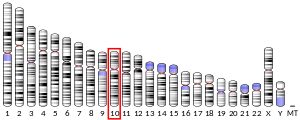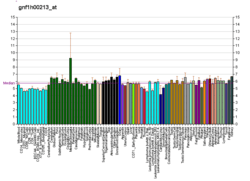SUFU
Suppressor of fused homolog is a protein that in humans is encoded by the SUFU gene.[5][6] In molecular biology, the protein domain suppressor of fused protein (Sufu) has an important role in the cell. The Sufu is important in negatively regulating an important signalling pathway in the cell, the Hedgehog signalling pathway (HH). This particular pathway is crucial in embryonic development. There are several homologues of Sufu, found in a wide variety of organisms.
Function
SUFU encodes a component of the sonic hedgehog (SHH) / patched (PTCH) signaling pathway. Mutations in genes encoding components of this pathway are deleterious for normal development and are associated with cancer-predisposing syndromes (e.g., holoprosencephaly, HPE3, basal cell nevus syndrome, BCNS, and Greig cephalopolysyndactyly syndrome, GCPS).[6]Sufu has also been found to have a crucial role in tumour suppression. To be more specific, it has a tumour-suppressor gene that predisposes, or in other words makes individuals more susceptible to medulloblastoma, because it modulates the SHH signalling pathway.[7] The N-terminal domain, which this entry refers to contains Gli transcription factors.[8]
Conservation
The human ortholog of Drosophila suppressor of fused, has a conserved sequence, this means that particular amino acids have remained the same throughout evolution. Consequently, they have very similar roles in repressing Hedgehog signalling. It represses the Gli and Ci transcription factors of the Hedgehog pathway,[14] and functions by binding to these proteins and preventing their translocation to the nucleus. Homologues of Sufu have been found in bacteria. However their function remains to be elucidated.
Structure
Sufu is actually protein that contains two domains.[8] In eukaryotic Sufu, an additional domain is found at the C terminus of the protein. This protein domain also binds to the C-terminal domain of the Gli/Ci transcription factors, inhibiting their activity.<ref name="pmid15367681">
Genes
Human gene that encodes SUFU, also named SUFU, is found to be localized on chromosome 10q24–25, and contains 12 exons.[14]
References
- GRCh38: Ensembl release 89: ENSG00000107882 - Ensembl, May 2017
- GRCm38: Ensembl release 89: ENSMUSG00000025231 - Ensembl, May 2017
- "Human PubMed Reference:". National Center for Biotechnology Information, U.S. National Library of Medicine.
- "Mouse PubMed Reference:". National Center for Biotechnology Information, U.S. National Library of Medicine.
- Merchant M, Vajdos FF, Ultsch M, Maun HR, Wendt U, Cannon J, Desmarais W, Lazarus RA, de Vos AM, de Sauvage FJ (Sep 2004). "Suppressor of fused regulates Gli activity through a dual binding mechanism". Mol Cell Biol. 24 (19): 8627–41. doi:10.1128/MCB.24.19.8627-8641.2004. PMC 516763. PMID 15367681.
- "Entrez Gene: SUFU suppressor of fused homolog (Drosophila)".
- Taylor MD, Liu L, Raffel C, Hui CC, Mainprize TG, Zhang X, Agatep R, Chiappa S, Gao L, Lowrance A, Hao A, Goldstein AM, Stavrou T, Scherer SW, Dura WT, Wainwright B, Squire JA, Rutka JT, Hogg D (July 2002). "Mutations in SUFU predispose to medulloblastoma". Nat. Genet. 31 (3): 306–10. doi:10.1038/ng916. PMID 12068298.
- Das D, Finn RD, Abdubek P, Astakhova T, Axelrod HL, Bakolitsa C, et al. (2010). "The crystal structure of a bacterial Sufu-like protein defines a novel group of bacterial proteins that are similar to the N-terminal domain of human Sufu". Protein Sci. 19 (11): 2131–40. doi:10.1002/pro.497. PMC 3005784. PMID 20836087.
- Stone DM, Murone M, Luoh S, Ye W, Armanini MP, Gurney A, Phillips H, Brush J, Goddard A, de Sauvage FJ, Rosenthal A (December 1999). "Characterization of the human suppressor of fused, a negative regulator of the zinc-finger transcription factor Gli". J. Cell Sci. 112 (23): 4437–48. PMID 10564661.
- Kogerman P, Grimm T, Kogerman L, Krause D, Undén AB, Sandstedt B, Toftgård R, Zaphiropoulos PG (September 1999). "Mammalian suppressor-of-fused modulates nuclear-cytoplasmic shuttling of Gli-1". Nat. Cell Biol. 1 (5): 312–9. doi:10.1038/13031. PMID 10559945.
- Dunaeva M, Michelson P, Kogerman P, Toftgard R (February 2003). "Characterization of the physical interaction of Gli proteins with SUFU proteins". J. Biol. Chem. 278 (7): 5116–22. doi:10.1074/jbc.M209492200. PMID 12426310.
- Humke EW, Dorn KV, Milenkovic L, Scott MP, Rohatgi R (April 2010). "The output of Hedgehog signaling is controlled by the dynamic association between Suppressor of Fused and the Gli proteins". Genes Dev. 24 (7): 670–82. doi:10.1101/gad.1902910. PMC 2849124. PMID 20360384.
- Rual JF, Venkatesan K, Hao T, Hirozane-Kishikawa T, Dricot A, Li N, Berriz GF, Gibbons FD, Dreze M, Ayivi-Guedehoussou N, Klitgord N, Simon C, Boxem M, Milstein S, Rosenberg J, Goldberg DS, Zhang LV, Wong SL, Franklin G, Li S, Albala JS, Lim J, Fraughton C, Llamosas E, Cevik S, Bex C, Lamesch P, Sikorski RS, Vandenhaute J, Zoghbi HY, Smolyar A, Bosak S, Sequerra R, Doucette-Stamm L, Cusick ME, Hill DE, Roth FP, Vidal M (October 2005). "Towards a proteome-scale map of the human protein-protein interaction network". Nature. 437 (7062): 1173–8. doi:10.1038/nature04209. PMID 16189514.
- Rubin JB, Rowitch DH (July 2002). "Medulloblastoma: a problem of developmental biology". Cancer Cell. 2 (1): 7–8. doi:10.1016/S1535-6108(02)00090-9. PMID 12150819.
Further reading
- Kogerman P, Grimm T, Kogerman L, et al. (1999). "Mammalian suppressor-of-fused modulates nuclear-cytoplasmic shuttling of Gli-1". Nat. Cell Biol. 1 (5): 312–9. doi:10.1038/13031. PMID 10559945.
- Stone DM, Murone M, Luoh S, et al. (2000). "Characterization of the human suppressor of fused, a negative regulator of the zinc-finger transcription factor Gli". J. Cell Sci. 112 (23): 4437–48. PMID 10564661.
- Murone M, Luoh SM, Stone D, et al. (2000). "Gli regulation by the opposing activities of fused and suppressor of fused". Nat. Cell Biol. 2 (5): 310–2. doi:10.1038/35010610. PMID 10806483.
- Delattre M, Briand S, Paces-Fessy M, Blanchet-Tournier MF (2001). "The Suppressor of fused gene, involved in Hedgehog signal transduction in Drosophila, is conserved in mammals". Dev. Genes Evol. 209 (5): 294–300. doi:10.1007/s004270050255. PMID 11252182.
- Cheng SY, Bishop JM (2002). "Suppressor of Fused represses Gli-mediated transcription by recruiting the SAP18-mSin3 corepressor complex". Proc. Natl. Acad. Sci. U.S.A. 99 (8): 5442–7. doi:10.1073/pnas.082096999. PMC 122788. PMID 11960000.
- Taylor MD, Liu L, Raffel C, et al. (2002). "Mutations in SUFU predispose to medulloblastoma". Nat. Genet. 31 (3): 306–10. doi:10.1038/ng916. PMID 12068298.
- Dunaeva M, Michelson P, Kogerman P, Toftgard R (2003). "Characterization of the physical interaction of Gli proteins with SUFU proteins". J. Biol. Chem. 278 (7): 5116–22. doi:10.1074/jbc.M209492200. PMID 12426310.
- Strausberg RL, Feingold EA, Grouse LH, et al. (2003). "Generation and initial analysis of more than 15,000 full-length human and mouse cDNA sequences". Proc. Natl. Acad. Sci. U.S.A. 99 (26): 16899–903. doi:10.1073/pnas.242603899. PMC 139241. PMID 12477932.
- Clark HF, Gurney AL, Abaya E, et al. (2003). "The secreted protein discovery initiative (SPDI), a large-scale effort to identify novel human secreted and transmembrane proteins: a bioinformatics assessment". Genome Res. 13 (10): 2265–70. doi:10.1101/gr.1293003. PMC 403697. PMID 12975309.
- Paces-Fessy M, Boucher D, Petit E, et al. (2004). "The negative regulator of Gli, Suppressor of fused (Sufu), interacts with SAP18, Galectin3 and other nuclear proteins". Biochem. J. 378 (Pt 2): 353–62. doi:10.1042/BJ20030786. PMC 1223961. PMID 14611647.
- Taylor MD, Zhang X, Liu L, et al. (2004). "Failure of a medulloblastoma-derived mutant of SUFU to suppress WNT signaling". Oncogene. 23 (26): 4577–83. doi:10.1038/sj.onc.1207605. PMID 15077159.
- Deloukas P, Earthrowl ME, Grafham DV, et al. (2004). "The DNA sequence and comparative analysis of human chromosome 10". Nature. 429 (6990): 375–81. doi:10.1038/nature02462. PMID 15164054.
- Gerhard DS, Wagner L, Feingold EA, et al. (2004). "The status, quality, and expansion of the NIH full-length cDNA project: the Mammalian Gene Collection (MGC)". Genome Res. 14 (10B): 2121–7. doi:10.1101/gr.2596504. PMC 528928. PMID 15489334.
- Rual JF, Venkatesan K, Hao T, et al. (2005). "Towards a proteome-scale map of the human protein-protein interaction network". Nature. 437 (7062): 1173–8. doi:10.1038/nature04209. PMID 16189514.
- Lyle R, Radhakrishna U, Blouin JL, et al. (2006). "Split-hand/split-foot malformation 3 (SHFM3) at 10q24, development of rapid diagnostic methods and gene expression from the region". Am. J. Med. Genet. A. 140 (13): 1384–95. doi:10.1002/ajmg.a.31247. PMID 16691619.
External links
- Eukaryotic Linear Motif resource motif class LIG_SUFU_1





